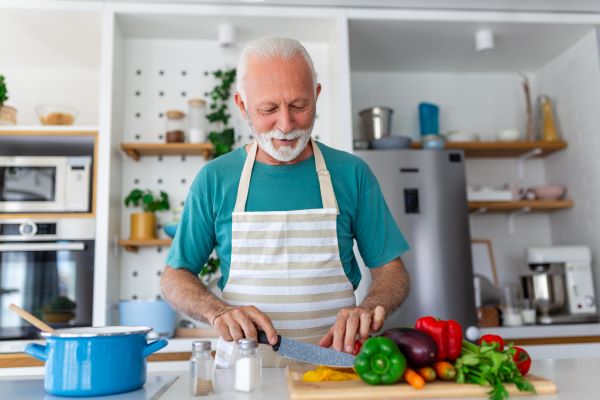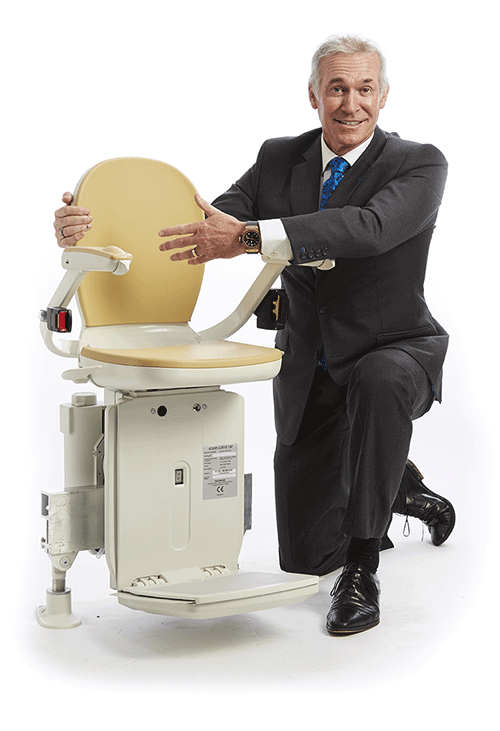Cutting. Peeling. Seasoning. Mixing. Measuring. Draining. Kneading. Sautéing. Steaming.
It all boils down to this—Cooking can be complicated.
Rather than biting off more than you can chew when cooking in the kitchen and turning this art from fun to frustrating, here’s some food for thought.
Make cooking as a senior into a piece of cake with these 7 helpful appliances, tools, and gadgets, that will turn your kitchen nightmare into a chef’s dream.
The Top Kitchen Appliances and Utensils Seniors Need in Their Kitchens
1. Don’t Start Off on the Wrong Foot— The Anti-Fatigue Mat
Cooking can be exhausting, sometimes requiring you to stand for hours on your feet in the kitchen.
Just as the name suggests, anti-fatigue mats are mats that are designed to reduce fatigue by absorbing the impact of standing for long periods of time while cooking.
Standing for long durations of time can lead to discomfort, fatigue, and pain for seniors with joint issues or reduced mobility, so anti-fatigue mats provide comfy cushioning and solid support, reducing the pressure on your joints and muscles and alleviating discomfort.
Beyond easing your aches and pains, anti-fatigue mats also possess the power to prevent dangerous slips and falls in the kitchen.
With seniors being at a much higher risk of falls due to factors such as balance issues and reduced reflexes, an anti-fatigue mat's cushioning and non-slip properties can help prevent slips and falls in the kitchen. This is especially important around areas where water or spills might occur.
Thanks to the added comfort, safety, and reduced strain that an anti-fatigue mat provides, seniors might be able to stand and work in the kitchen for longer periods without experiencing as much discomfort or dangerous injuries.
2. Pull Your Kitchen Together—Pull-Out Shelves
How many times have you found your outstretched hand fumbling around the back of your cabinet in frustration for that pepper shaker that has drowned in a sea of spices?
The truth is that traditional cabinets can sometimes result in items getting buried at the back, making it challenging to see and retrieve them. However, pull-out shelves provide clear visibility of all items, making it easier for seniors to locate what they need without having to rummage through the cabinet.
Because pull-out shelves extend fully from the cabinet, seniors are able to easily access items at the back of the shelf without needing to stretch, bend, or reach deep into the cabinet.
This eliminates the need to strain or overextend themselves, ultimately reducing the risk of injury.
3. Don’t Slip Up—Non-Slip Utensils
Gripping utensils with smooth handles can require more force and tension, leading to hand fatigue, discomfort, and dropping dangerous tools in the kitchen.
However, non-slip handles reduce the need for excessive gripping, minimising strain on the hands and fingers.
Non-slip utensils are designed with textured or rubberised handles that provide a secure grip, which is particularly useful for seniors who may have reduced hand strength or dexterity, as it helps them hold utensils more comfortably with less effort.
In fact, many non-slip utensils are designed with ergonomics in mind, catering to the needs of seniors with arthritis, limited grip strength, or other hand-related challenges.
Another surprising benefit of using non-slip utensils is that they can even create a safer cooking environment for seniors.
For example, seniors might have a higher risk of dropping utensils while cooking due to age-related factors like decreased hand-eye coordination.
Conversely, this means that maintaining better grip and control over utensils lead to fewer accidents while cooking, ultimately reducing the risk of burns or other injuries caused by falls, slips, and mishandling utensils.
Secure gripping utensils also cut back on cleanup time, as they reduce the likelihood of accidentally dropping or spilling food, offering better control over food while cooking and eating.
For all of these reasons, gripping utensils can lead to an overall neater, more organised cooking and dining experience, in which seniors are able to truly enjoy their time spent in the kitchen and at the dinner table.
4. Pull Your Own Weight in the Kitchen—The Travelling Trolley
Cooking can not only get messy, but it can also get heavy.
You may have bitten off more than you can chew, convincing yourself that you can carry the cluttered collection of utensils, ingredients, appliances, pots, and pans needed for your lemon chicken recipe all at once.
However, this scenario can easily turn from efficient to dangerous, as failing to successfully carry kitchen supplies can lead to falling knives, broken glass, and throbbing toes.
The solution to being efficient while avoiding these accidents is a travelling trolley.
A trolley allows seniors to conveniently move items around the kitchen without needing to carry heavy pots, pans, or ingredients, reducing the risk of falls or strain.
Eliminating the need for seniors to lift heavy objects, pushing a trolley requires much less physical effort than carrying items, which can be particularly challenging for those with reduced strength or joint issues.
Ultimately, this reduces the strain on muscles and joints, making meal preparation and cooking more comfortable for seniors.
Instead of struggling with the heaviness of kitchen supplies, you can turn your attention toward trying not to be too heavy-handed on the seasoning.
5. Don’t Flip Your Lid— The Electric Can Opener
Let’s face it. We’ve all struggled with a manual can opener at one point or another in our lives, desperately trying to position the dull blade at the perfect angle against the stubborn lid.
Rather than flipping your lid over a can of beans, you can choose to opt for the convenient electric can opener instead.
While a manual can opener can be especially difficult and uncomfortable for seniors who experience arthritis and joint pain, electric can openers are designed to be user-friendly with simple one-touch operation.
An electric can opener that operates with a simple push-button mechanism can reduce the strain on sensitive joints for seniors with reduced hand strength, making the process much simpler and practically painless for them.
6. Open Sesame—The Jar Opener
Don’t you wish that opening a stubbornly secured jar lid were as easy as saying “open sesame?”
Well, wish granted. I present to you the genius invention of the handy, dandy jar opener.
Frustratingly, as we have all experienced, traditional methods of opening jars, like using brute force or tapping the lid, can be tiring and ineffective, not to mention time-consuming.
Seniors might have decreased hand strength or grip due to age-related factors or conditions like arthritis, with joint pain and stiffness, finding it particularly challenging to open jars.
However, a jar opener allows them to bypass this need for significant strength, instead relying on the tool's mechanics.
A jar opener’s ergonomic design provides extra leverage, making it easier to twist open tight lids without putting excessive strain on the hands and fingers.
This can provide significant relief for seniors by minimising the strain on sensitive joints and preserving precious time that can be better used on other tasks.
7. Don’t Stir the Pot—The Automatic Pan Stirrer
Sometimes cooking can almost feel like babysitting, as you must keep a sharp eye on your food at all times, stirring frequently to ensure that it does not burn or stick to the pan.
This can require continuous manual effort and supervision, which can be tiring, draining, and overwhelming—especially for seniors with limited hand strength or mobility.
However, an automatic stirrer is your personal babysitter, eliminating the need for constant stirring, and reducing physical strain and fatigue by consistently moving the food in the pan for you.
An automatic pan stirrer also helps ensure an even distribution of heat and flavors throughout the dish, which is particularly important for seniors who might have difficulty maintaining a consistent stir due to physical limitations.
This allows seniors to focus on other aspects of cooking, such as preparing ingredients or monitoring the overall progress of the dish, without having to constantly attend to the stirring process.
By reducing the physical demands of cooking, an automatic stirrer, alongside all of these other useful kitchen tools, allows seniors to continue cooking with safety, ease, and efficiency.
These useful tools help keep senior chefs in the kitchen, allowing them to fully enjoy the cooking experience and continue doing what they love.

